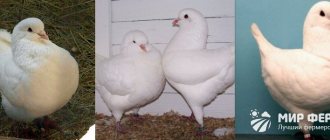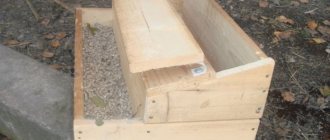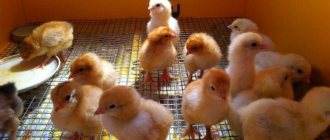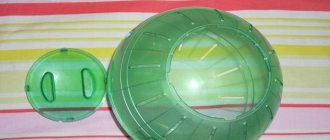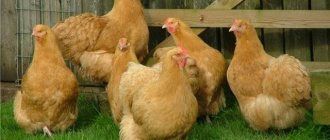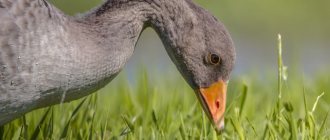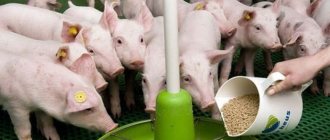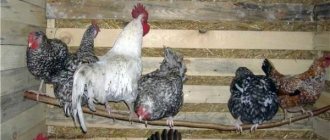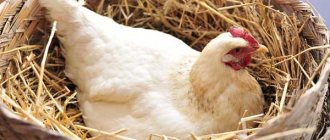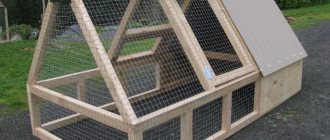Home » Articles about pigeons » Feeder for pigeons
The health of the livestock depends on the design of the pigeon feeder and the material used. There are plastic and metal feeders of hopper and tray types on sale. You can make them yourself using accessible and inexpensive materials.
Primary requirements
The container should be comfortable for the birds so that the birds do not interfere with each other. Feeding areas are usually demarcated by vertical partitions. If they are not provided, then there should be enough space for all birds - if necessary, you need to increase the number of feeders.
A prerequisite is the convenience of maintaining hygiene. To prevent debris and droppings from getting into the feed, birds not scattering it and spoiling the sediment, protection is provided (a “canopy” is built, horizontal jumpers are installed). Separate feeding areas are planned for chicks and adult pigeons in the dovecote.
General requirements for the equipment of a pigeon feeder
If the feeder is made correctly, then you will have fewer problems with care, since a lot depends on this factor: sanitary cleanliness, the comfort of the birds and the ease of cleaning the dovecote. Of course, you can take a regular container, but for the chicks this will be a real test, and they will be in a state of stress.
It may also happen that you have to be away for some time, and there is no one to ask to look after the dovecote. In this case, this unique dining room for your pets is the optimal solution.
People experienced in breeding pigeons advise separating feeders for adult pigeons and babies. After all, the chicks are unusual in being among adults and experienced individuals, and they will most likely be afraid to even approach the dining room.
There are two types of feeders for our feathered friends:
- automatic;
- boxed
Regardless of what type you want to build, it is important to remember the general requirements for any of them:
- birds must have immediate access to food;
- the constructed structure should well protect the feed from debris and precipitation;
- the design should be such that it is easy to clean;
- dirt from pigeon legs should not fall on the prepared food.
Materials
Feeders are made from environmentally friendly materials - plastic, metal, wood.
Plastic
This material does not emit toxic substances, the edges are not sharp - the bird cannot get hurt. Plastic containers are hygienic and suitable for all types of feed. Thin-walled feeders are unreliable - pigeons can turn them over, so additional fastening or weighting is required (a weight is placed on the bottom).
Tree
The material is natural, strong, durable. It is well suited for dry food, but wet mash should not be used. The downside is the presence of sharp splinters (splinters) - the surface must be treated with sandpaper to remove all irregularities and smooth the edges.
Metal
Metal is the most reliable material. Metal containers are stable and suitable for all types of feed. Hygiene is easy to maintain - dirt can be easily removed, and if necessary, you can disinfect the surface using a burner. Disadvantage: sharp edges can injure pigeons; be sure to bend the metal edge.
What is best to make it from: choosing the material
The choice of material from which the feeder will be made also plays an important role. Experienced pigeon breeders always choose more durable materials, since they are primarily interested in the durability of the structure. But you can also use less durable materials, such as cardboard or plastic.
To make it easier for you to make a choice, we list the pros and cons of the most popular materials for making a pigeon feeder.
Plastic. One of the most popular options for such a device, which has many advantages:
- easy accessibility;
- due to the transparent walls of the structure, birds will be able to see the food from afar;
- easy to handle;
- minimum trash and waste;
- no special tools are needed to create such a feeder;
- resistance to changes in temperature and humidity;
- The plastic product is quite durable and will last for many years.
The only drawback that is inherent in plastic is its light weight, so the feeder must be well secured.
Cardboard. The advantages of this material:
- ease of work;
- easy accessibility (there is always an unnecessary box in the house).
But, perhaps, such material will have more disadvantages:
- the cardboard structure will not withstand heavy rainfall, so it is only suitable for the warm season (but in case of rain it will have to be removed);
- such a design will not be durable: it will only last for a couple of months;
- the weight of the cardboard feeder will be very light, so to prevent it from being blown away by the wind, you will have to make additional reinforcements and add something to the feeder itself to make it heavier;
- cardboard is not the most durable material and can be easily damaged.
Tree. Its advantages include:
- reliability;
- strength;
- durability (if the tree is also treated with a special solution, for example, drying oil, water-polymer emulsion, etc., the manufactured feeder will serve for many years);
- environmental friendliness.
Wood is probably the best choice in terms of durability and longevity, but making this type of feeder will require additional tools and at least basic woodworking skills.
Homemade wooden structure
The size of the pigeon feeder depends on the number of pigeons. To make it yourself you will need slats and plywood:
- 20x40 mm – 2 pcs.;
- 20x20 mm – 1 pc.;
- plywood - strip 13 cm wide.
The standard option for a large dovecote is 1.5 m.
2 parts in the shape of a “house” are cut out of plywood. The width of the base is 13 cm, the height to the bevel angle is 17 cm. From this point to the top, measure 5-6 cm. In the upper part, the corner of the “roof” is cut off - a platform 2-3 cm wide is formed (you don’t have to do this).
On the narrow side of strip No. 1, 20x40 mm, markings are made every 5 cm. On strip No. 2, 7.5 cm are retreated from the edge, and then markings are made every 5 cm.
The markings from rail No. 1 are transferred to one side of the narrow 20x20 mm strip and the corresponding mark is made (No. 1) so that you can navigate when assembling the structure. The markings are transferred to the other side from rail No. 2. Holes (not through holes) are made along the marks.
At the next stage, 20x40 mm strips are screwed to the bottom from one and the other edge. Parts in the shape of a “house” are screwed onto the end sides. On each of these parts, 17 cm from the bottom edge in the center, marks are made for a screw. In a 20x20 rail, the center is marked in the end parts. It is screwed in accordance with the marks (No. 1 and No. 2) - the holes at the top and bottom will be at the same level.
Prepare pieces of hardened wire 14 cm long. One end of each piece is inserted into the upper bar, the other into the lower one. The top can be covered with a “roof” by cutting out 2 parts from plywood.
How to make a drinking bowl?
Feeding pigeons involves providing them with water, so it is necessary to make a drinking bowl. There are different ways to do this.
Automatic heated drinker
It is used during frosts so that the liquid does not freeze and the birds can always drink. The drinking bowl consists of the following elements: stand; a heating device, a drinking container, a bottle with a dosing tube that is filled with liquid. How to do:
- The container is a round container made of plastic material, in which you need to make a hole on the side through which the pigeons will drink. It should be at a distance of 6-10 cm from the bottom.
- A tin can filled with paraffin is suitable for the burner. A wick must be installed (you can use asbestos rope). Instead of fuel, an ignition agent is used.
- The stand should also be made of tin. A burner is installed on it and ignited. The top is covered with a protective case made of tin, in which several holes must be made (gas exchange is created).
- A plastic drinking bowl with a small weight is installed on top, so it does not tip over. In the upper part of the container, you need to make a round hole the diameter of a 1.5 liter plastic bottle. It is this that is filled with water and inserted into the drinking bowl upside down. A dosing tube is installed inside to prevent liquid from overfilling the drinker. Thus, as the container is emptied, the drinking bowl gradually fills with water.
An example of making another automatic drinker is shown in the video below:
Bunker structures
The bunker capacity makes it possible not to worry about constant replenishment of feed supplies. It is enough to pour it into the bunker once - as the grain mixture in the lower container decreases, a new portion will arrive there. The photo below shows a classic bunker feeder.
From plastic bottles
For production you will need a plastic bottle with a capacity of 5-6 liters. The bottom is cut off in such a way that the 2nd part inserted into it with the neck down does not reach the bottom by about 5 cm. The bottom serves as a feeder. At a height of 4 cm, holes are cut for access to the feed. The top is used as a bunker into which the feed will be poured.
You can use a stand for reliability - vertical jumpers are fixed on a stable horizontal base, to which the “hoppers” will be attached (the pitch between the jumpers is equal to the diameter of the container). The bottom of the bottle is placed on a flat base. The upper part of the container is fixed on the vertical jumpers so that the neck is located no higher than the edge of the lower one.
From plastic pipes
You can make a horizontal feeder for pigeons with your own hands from a plastic pipe with a diameter of 110 mm.
You will need 2 pieces of 1 meter each. A long hole is cut on one part from one edge to the other or a series of holes are made side by side. One side of each pipe section is closed with plugs. The free edges are inserted into the knee. The structure is placed near the wall and fixed. The side with the holes is positioned horizontally. The second side plays the role of a bunker - it is mounted vertically.
Step-by-step instructions for making your own feeders
Wooden feeders
To create a structure made of wood, you will need the following (the parameters are given as an example):
- plywood;
- boards - 4 pieces (two of them are 70x8 cm in size, the remaining ones are 25x20 cm);
- tin;
- wooden block 70 cm long;
- nails;
- slats.
The process of making a feeder in the form of a house:
- Put together a box from boards using fastening nails. The back and side walls should be high. Be sure to nail the cover from the board.
- Make a roof from 2 pieces of plywood, which should protrude above the structure.
- Separately make a pallet (movable) from plywood and slats. It is installed on the bottom of the feeder.
- Attach a weather vane to the roof to scare away birds (so that they don’t land on top).
- Nail a piece of wood so that between it and the bottom there is space for inserting a pull-out tray.
- Tin is needed to create restrictive strips (cut into strips). They are mounted in front of the feeder in a vertical position. They are fixed between the lid and the bar.
Other options for wooden feeders are presented schematically below:
Cardboard feeder
Cardboard products can be made for temporary use (until you can make or purchase a more durable design). For this, you can use cardboard boxes of any size, but it is best to take a device for shoes (compacted cardboard, optimal size). Additionally, you need scissors and tape.
Work process:
- make holes for the rope in the corners of the lid and bottom;
- thread;
- hang it from a support.
These feeders can be used to feed wild birds in parks and yards.
From a cardboard box:
- give the box the appearance of a house;
- secure with tape;
- make holes for entry.
Such feeders can be hung on the balcony (when keeping pigeons at home) or placed on the floor in the dovecote (in this case, small pebbles must be placed at the bottom of the paper structure, which will serve as weighting devices so that the wind does not rock the structure).
Plastic feeder
For this purpose, 5- or 6-liter plastic bottles are used. They can be installed both vertically and horizontally, after cutting out holes for the birds.
How to make a feeder from a plastic bucket and a plastic bottle, see the video below:
Hopper automatic feeder
This method allows you to control the amount of feed supplied. You can immediately pour a significant amount of grain into such a feeder, which will flow into the feeding compartment as it is emptied. This is convenient if the owner of the dovecote leaves for several days (the pigeons will not go hungry). Feed is supplied automatically.
The design consists of 2 main compartments - a compartment for storing grain and a feeding tray:
How to make the simplest self-replenishing bunker feeder from a plastic bottle is shown in the video below:
Feeding pigeons
Baby pigeons should be fed separately from adults, since they will not get enough to eat when fed together. To make the structure you will need:
- plastic tray from a flower pot;
- metal grid;
- glass jar.
The length of the mesh section is 2 cm greater than the diameter of the neck of the glass container. Width – 5 cm. A ring is rolled up from the mesh so that it freely covers the neck (margin – 2-3 mm). Connect the edges with wire. On one side, a row of horizontal rods is cut off with pliers, leaving only the vertical ones. They are heated over a fire and pressed into a plastic tray, pierced through. The pins are bent on the back side, fixing the ring. Food is poured into the jar. A ring attached to a pallet is put on top. The structure is turned over.
Creating an automatic feeder
Unlike previous options, creating an automatic design will require a little more time and skill. But there are situations when it is necessary to excommunicate from home. In order for birds to have a sufficient amount of food and water, it is necessary to consider a dosed feeding system.
- We take a plastic round container and make holes in it with a diameter of 7-8 cm. Carefully process all the edges so as not to injure the birds when feeding.
Consider the height of the holes from the bottom - it should be at least 5-6 cm, otherwise it will be uncomfortable for the birds to stick their heads inside. Make holes in the drinking container - You can place a small weight at the bottom of the container to prevent birds from tipping the container over. You can use a regular abrasive wheel as a load, which, in addition to weight, will also play another function. During feeding, pigeons will be prevented from overgrowing their beaks, as in the wild.
- We close the container on top with a lid with a pre-made hole in it.
The hole should be 1.5 liters in diameter. Assembling the structure - Take a 1.5 liter plastic container and close it with a lid that has a small hole in it.
- Turn the bottle over and thread it through the lid of the container.
Keep in mind that the neck should not reach the bottom. Otherwise, the grain will not be fed under its own weight. Finished design
The advantage is the cleanliness of keeping pigeons. If you just put grain in a bowl, the birds will scatter it everywhere. It is also convenient to feed birds a mixture of grains. The birds will eat the food as it comes in, without individually choosing the most delicious grains.
In order to keep the dovecote clean, the structure must be placed in a plastic or metal tray. To clean your bird's dining room, simply remove the container and wash the tray.
You can find out more about how to make this design in the video.
Video - Do-it-yourself automatic feeder
Requirements and parameters of an ideal feeder
A properly selected feeder for pigeons plays an important role when breeding birds. The level of sanitary cleanliness, the comfort of the birds, and the convenience of cleaning the dovecote depend on this.
Of course, you can get by with simple containers into which to pour grain. But for small pigeons that are just leaving the nest, such a feeding regime will be very stressful. In addition, if the owner of a dovecote needs to go away for several days, and there is no one to entrust the farm to, creating such a canteen for birds will be the optimal solution.
Experienced pigeon breeders recommend creating separate feeders for adults and small pigeons to ensure comfort. After all, small chicks who have just left the nest and are gradually getting used to adult life are still afraid to approach a common feeder together with experienced adults.
Homemade feeders for pigeons
Feeders for birds can be divided into two types:
- automatic;
- boxed
A box feeder is much easier to make from available materials. At the same time, in terms of ease of maintenance and cleaning, it is not inferior to an automatic one.
In addition, if birds spend a lot of time outside, freely feeding on food from the ground, then the box type will be more familiar to them.
Feeder-drinker for pigeons
This is a universal type of feeder, which is made to organize the diet of chicks after you need to discourage them from the nest. Leaving the nest is a huge stress for babies, which is accompanied by changes in nutrition, so they need a feeder of a special design that can be used to pour food and pour water into different compartments at the same time.
In order to make it yourself, you will need some skills in working with tools, free time, as well as wooden boards, some nails, plywood and tin sheets.
- Take small boards and first make the frame of the main bunker, and then the pull-out tray.
- Cover the frame 1 cm with plywood.
- Using small pieces of tin, make access barriers (see the picture for a detailed description of the design and dimensions).
Drawing of homemade wooden feeders for pigeons
Pigeon drinking bowls
There are several ways to make a drinking bowl for pigeons. Which one to choose depends only on you, more precisely, on the amount of free time and the availability of the necessary materials.
An excellent option is a drinking bowl made of galvanized iron. To make it, you do not need any special skills, but there are still a number of important points that must be taken into account before making a drinking bowl. It is important that its length is optimal for pigeons, because when a bird drinks water, it immerses its head almost completely in the drinking bowl so that the water reaches its eyes. Take this into account, because otherwise the pigeons will decide that your drinking bowl is a great place for swimming and it will be difficult to achieve at least some purity of the water.
The basis of the drinker is a rectangular iron sheet 6 cm wide. The length in this case does not matter. Using pieces of iron, make the walls of the drinking bowl 8 cm high. Secure the resulting structure between two bars on the board.
But if there are a lot of pigeons under your care, then they will drink water from such a drinking bowl too quickly. Therefore, you need a reservoir from which water will flow into the structure as the pigeons consume it. To do this, you need to find a cylindrical container with rolled up sides. The depth of the container is 9 cm. You need to place a plastic bottle in it. Measure 4-5 cm from its bottom edge and make a small hole. Water will flow through it.
Remember that in the hot summer, the pigeons' need for water increases. This is why the risk of water pollution increases.
Failure to comply with sanitary standards can cause infection. The best way out of this situation is to add a little disinfectant solution to the drinking bowl.
How to choose material for a feeder?
Metal feeders and drinkers are considered the most durable. However, at home you can build a structure from more affordable materials, such as plastic, wood, thick cardboard.
A fairly popular material from which bird feeders are made is plastic. It has several main advantages:
- availability;
- in this design, birds can clearly see the food even from a distance;
- processed without any difficulty;
- does not deform as a result of temperature changes;
- does not involve a large amount of waste;
- there is no need to purchase special equipment for manufacturing the structure;
- Such durable products will last for several years.
You can make a feeder from cut plastic bottles
The only disadvantage of plastic is its low weight, which is why birds often turn over such feeders. To prevent this, the structure should be pre-fixed - for example, if the feeder is made from cut bottles, they can simply be nailed to a wooden base.
Cardboard is a simple and affordable material from which various designs are made. Its main advantages can be highlighted:
- speed of making the feeder;
- You can use any unnecessary box as a basis.
However, the negative aspects of the material should also be highlighted:
- the feeder can be placed in a cage only in summer or spring; in the cold season it immediately becomes deformed from precipitation;
- the design is suitable for use for 1-2 months, so it will have to be replaced regularly;
- since the cardboard is very light, the feeder can be blown away by the wind; to avoid this, you will need to put a weighting agent in the inside;
- Birds can quickly damage this fragile material.
You can use a long and narrow cardboard box as a feeder.
Wood is often used to make bird feeders, because this material has obvious advantages:
- reliability;
- durability (when treated with special solutions or drying oil, it lasts for many years);
- environmentally friendly (the material is absolutely safe for birds).
The only downside is that wooden feeders are more difficult to disinfect than plastic or metal ones. In addition, to manufacture structures you must have certain skills.
Some poultry farmers make structures from galvanized steel. Such feeders have two main disadvantages - you will have to spend money on purchasing metal sheets, and you also need to have certain skills to manufacture them. Otherwise, such a feeder and drinker is the most environmentally friendly, especially compared to plastic, and durable.
